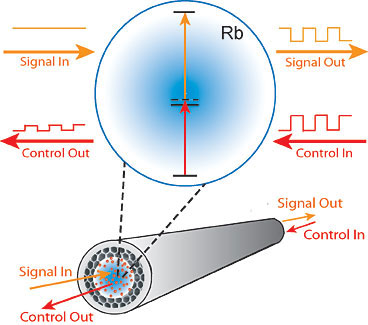| Nov 09, 2011 |
Switching light on and off - with just a few photons
|
|
(Nanowerk News) Cornell researchers have demonstrated that the passage of a light beam through an optical fiber can be controlled by just a few photons of another light beam.
|
|
Such all-optical control is the idea behind photonics, where beams of light replace electric currents in circuits, yielding higher speed and lower power consumption. Just as a transistor can switch an electric current on or off, photonic circuits need a way for one light beam to switch another. One of the holy grails is single-photon switching, where just one photon controls the passage of another.
|
|
Researchers in the Quantum and Nonlinear Optics group of Alexander Gaeta, professor of applied and engineering physics, have come close to that goal. They report their new approach in the Nov. 4 issue of the journal Physical Review Letters ("Few-Photon All-Optical Modulation in a Photonic Band-Gap Fiber").
|
 |
| Rubidium atoms will absorb photons only if two photons of specific wavelengths arrive at the same time. This allows one stream of photons to turn another on or off.
|
|
Light consists of small packets of energy called photons. Under the right conditions, a photon can be absorbed by an atom. Gaeta's group exploited the unusual property of the element rubidium, which can absorb photons only if two photons of certain wavelengths arrive at the same time. They filled a hollow-core optical fiber with rubidium vapor and fired a continuous infrared light signal at a wavelength of 776 nanometers (nm) in one end and an intermittent "control" signal at 780.2 nm in the other.
|
|
In the narrow tube, light interacts strongly with the rubidium atoms. When the control beam is on, rubidium atoms absorb both wavelengths, and the signal is cut off; when the control is off the signal passes through.
|
|
The effect is observed with less than 20 control photons at timescales as fast as five-billionths of a second, allowing modulation at frequencies up to 50MHz, the researchers said, referring to the rate of transmission of on and off pulses of light representing digital ones and zeroes in fiber-optic communication. The technique also may have applications in quantum computing, where single photons can act as "qubits," the quantum equivalent of ones and zeroes.
|
|
The research was funded by the National Science Foundation and the Defense Advanced Research Projects Agency.
|

